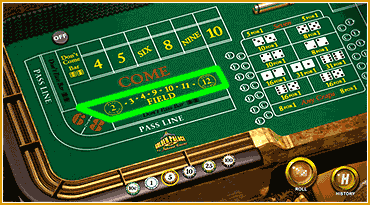- Craps Betting The Field Strategy Against
- Craps Betting The Field Strategy Games
- Craps Betting The Field Strategy Tactics

- Risking loss bet on EVERY FIELD seems like the road to ruin. You could wait for 3 or 4 NOT A FIELD to show and chase no more than one time Wagering select Don't Pass offers a more productive martingale. On a typical craps table,were you to not bet a shooters first two Pass Line and Wager Don't Pass on the shooter's third Pass and IF.
- Of course, craps players should always remember that the house advantage jumps to 5.55% in case that the Field paid double on both 2 and 12, so they are not recommended to use it. However, this betting pattern could turn out effective in order for the player to draw profit at a time when the table is cold.
- Best Craps Bets. The primary aim of betting providers is to take the money of clients, and your main purpose is to prevent this by placing good wagers. To help you achieve success, we will list some of the best bets in craps. Thus, understanding the best craps bets, you will be able to develop a winning craps betting strategy and avoid losing cash.

In 120 rolls of the dice, the ‘inside betting’ strategy will see a decision two-thirds of the time, that’s 80 decisions, that’s $1760 wagered, with the house keeping approximately $46. Basic Gist: Wait five non 7 rolls and place a bet on the one roll bet for the 7. Uses Martingale System of betting progression. Max Loss – Huge The method basically entails having about $200-400 in chips on your tray, so that you can once again chase any losses up at least 6 rolls if necessary.
The title of this post is a misnomer. I wanted to write a post covering the other bets at the craps table, assuming if you’re reading this then you might already know the basics of how casino craps work, I thought we could call these “intermediate craps bets.”
But the truth is that these bets are all worse than the basic bets in craps. When playing craps the best players in the world stick with five bets:
- Pass
- Don’t pass
- Come
- Don’t come
- Odds
Those are the best bets in the game, and you don’t even need to place any other bets.
But if you want to know why, read on for information about the other bets on the craps table:
The Field Bet
The field bet is one of the best of a bad lot. It’s a one-roll bet, which means it gets resolved based on what happens on the next roll of the dice.
The field bet wins even money if a 3, 4, 9, 10, or 11 is the result.
Craps Betting The Field Strategy Against

And the field bet pays double if a 2 or 12 is rolled.
If any other number gets rolled, the field bet loses.
Craps Betting The Field Strategy Games
The house edge for the field bet is 2.77%, which is roughly twice that of the pass line bet with its house edge of 1.41%.
I don’t recommend placing the field bet, but if you need to do something besides pass or don’t pass, come or don’t come, and odds, this is one of the only reasonable bets on the table.
Place Bets
A place bet can be a good deal, too, at least when contrasted with most of the other bets on the table. A place bet is similar to an odds bet, but instead of winning based on the point that was set by the shooter, you get to choose your own point.
For example, you can bet place 4 or place 10. Or you can bet place 4 or place 9.
If you bet place 6 or place 8, the payoff is 7 to 6. The odds of winning, of course, are 6 to 5, so the house edge on this one is 1.5%.
That makes this a reasonable bet to place.
Some players also like place 5 or place 9. The payoff for either of those is 7 to 5, and the house edge is 4%.
Most people, with good reason, stay away from the place 4 or place 10 bet. The payoff for that one is 9 to 5, and the house edge is 6.7%.
Feel free to make a place 6 or place 8 bet anytime you like, with my blessing.
Skip the other place bets, though.
Buy Bets
The buy bets are just like a place bet or an odds bet. But they have their own wrinkles, too.
The buy bets pay out at true odds, just like an odds bet would.
But you pay a 5% commission on these bets.
This makes the house edge for any of these bets 4.76%.
This means it’s crazy to buy 6 or buy 8, even though those options are available to you. The same bet with a slightly lower payout when you win is the place 6 or place 8 bet.
It sort of makes sense to place a buy 4 or buy 10, but it’s better just to skip it, there, too. The house edge is lower than it would be if you bet place 4 or place 10, but there are so many bets that are so much better for the player on the table that you shouldn’t bother with either of them.
Lay bets are just like buy bets, but they’re for wrong bettors. They pay out just the same as if you were laying the odds, but the casino takes that 5% commission.
The Proposition Bets
The proposition bets are the worst bets on the table and should be avoided at all costs. And it might take some self-control to avoid them because the stickman is shilling those bets. A good stickman can get players excited about these bets even when they know the odds are lousy.
Some people love prop bets because you don’t have to risk much to place these bets. You can bet as little as a dollar at most casinos. The problem is that the house edge is so high that even at a dollar a bet, you’ll still lose a lot of money fast making those bets.
Proposition bets are one-roll bets that usually offer big payouts.
Here are some examples of prop bets along with their payouts and the house edge for each. Remember that the house edge is the average amount of each bet you’ll lose in the long run based on the probabilities.
- Any craps is a bet that wins if the next roll lands on 2, 3, or 12. The payoff is 8 for 1 (or 7 to 1, depending on how you look at it.) The house edge is 11.1%.
- Any seven is a bet that wins if the next roll lands on a total of 7. The payoff is 5 for 1 (or 4 to 1). The house edge is 16.9%.
- Eleven is a bet that the next roll lands on a total of 11. The payoff is 16 for 1 (or 15 to 1). The house edge is 11.1%.
- You can also bet on a three result. That has the same odds and payouts as a bet on eleven.
- Snake-eyes is a bet that the total will be 2. It’s one of the highest-paying bets on the table, with a payout of 31 for 1 (or 30 to 1). The house edge for that bet is 13.9%.
- You can also bet on a total of twelve. That has the same odds and the same payouts as the bet on snake-eyes.
Just save yourself some misery and skip the prop bets.
The Hardway Bets
A hardway bet is a bet on a total of 4, 6, 8, or 10, but it only wins if you get a pair that results in the total. Any other combination that adds up to that number is an “easy” total.
This is a multi-roll bet that loses if the 7 or the easy total comes up before the hard total comes up.
The hardway bets are longshots with a big payout. If you bet hard 4 or hard 10, you get a 7 to 1 payout, and the house edge is 11.1%.
If you bet hard 6 or hard 8, you get a 9 to 1 payout, and the house edge is 9.09%.
I don’t suggest taking a hardway bet, but if you do, bet hard eight. At least that’s got a cool sound to it.
You also get a better payout when you win, and you face a lower house edge.
How the House Gets Its Edge
I’m going to give one example of how the house gets its edge here, but you can use the same thought process to calculate the house edge for any of these bets.
Let’s look at the hard 6 bet. The odds of winning that bet are based on the number of ways you can win (there’s just one) and the number of ways you can lose (any 7 and any easy 6).
- You can roll a total of 7 in any of 6 different ways.
- You can roll an easy total of 6 in any of 4 different ways.
This means that that’s 10 ways to lose and 1 way to win, or 10 to 1 odds.

The payoff when you win is 9 to 1.
Suppose you place this bet 11 times, wagering $100 each time, and you saw statistically perfect results. (When you calculate the house edge, you always assume statistically perfect results.)
- You’ll lose that $100 on 10 of those rolls, for a loss of $1000.
- You’ll win $900 on one of those rolls.
- Your total loss over the 11 rolls is $100.
- That’s $9.09 average per bet, or 9.09%.
The difference between the odds of winning and the payout odds is where the house edge comes from, every time. Here you can find out more about the craps bets ranked according to the house edge.
Conclusion
Between my previous post about the basic bets in craps and this post about the intermediate bets in craps, you know just about everything there is to know about craps betting.
But I might have gotten something wrong or left something out. If that’s the case, would you do me a favor and leave a comment?
